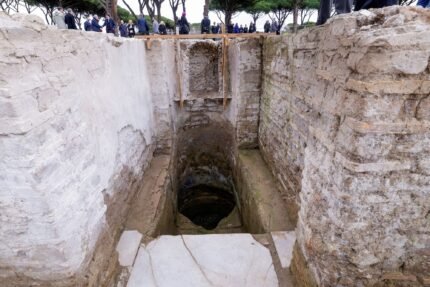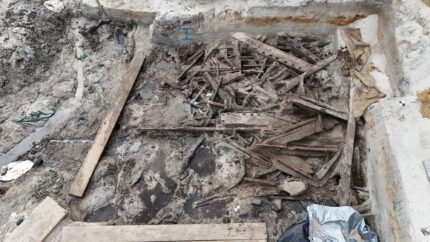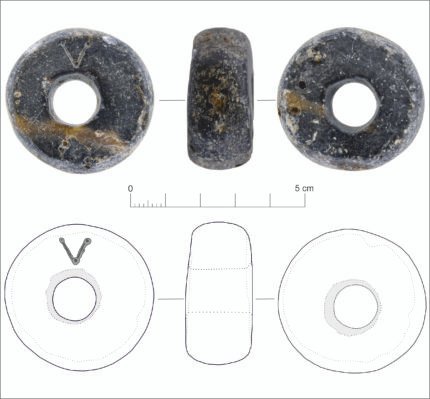Archaeologists excavating the ancient site of Ephesus in modern-day Selcuk in western Turkey have discovered a 3rd-century sarcophagus that originally belonged to a gladiator. His remains were never found because the sarcophagus was reused in the 5th century to bury 12 bodies.
 Inscriptions on the outside of the sarcophagus identify the original owner as a gladiator named Euphrates. Two centuries after his death, the sarcophagus was reused and three crosses were carved inside. Later, probably in the 7th and 8th centuries AD, more crosses were carved on the coffin lid.
Inscriptions on the outside of the sarcophagus identify the original owner as a gladiator named Euphrates. Two centuries after his death, the sarcophagus was reused and three crosses were carved inside. Later, probably in the 7th and 8th centuries AD, more crosses were carved on the coffin lid.
[Excavation leader Sinan] Mimaroglu was amazed to find water channels, drainage systems, mosaics and several tombs just 20 centimeters underground.
“We found a tomb and three tomb-like structures with 12 people buried inside. This suggests it was a mass burial,” he said, stressing the importance of this Roman tomb with its elaborate inscriptions and Christian symbols added during its later use.
Mimaroglu provides information on the church associated with the mausoleum. It was originally a small funerary structure, later converted into a wooden-roofed basilica during the reign of Justinian I, and eventually into a domed church.
He noted that “the burials inside the church most likely belonged to the upper class or clergy, as it is unlikely that ordinary people would be buried in such a detailed manner inside a church.”
Archaeologists have not found any directly comparable similar tombs elsewhere. Tombs with similar cross reliefs but made of lower quality materials have been found in Istanbul. Tombs made of similar materials have been found on the island of Marmara and in Syria, but in these cases the designs of the crosses differ.
 Ayasuluk and the 6th century Basilica of St. John were first excavated in 1921-22, and since then, evidence has been found dating back to the 2nd millennium BC. An early Bronze Age settlement on Ayasuluk is thought to have been Apsa, the capital of the independent kingdom of Arza, and cemeteries from the Mycenaean era (1500-1400 BC) have been found near the church. The ancient Greek city of Ephesus was discovered on Ayasuluk in the 10th century BC.
Ayasuluk and the 6th century Basilica of St. John were first excavated in 1921-22, and since then, evidence has been found dating back to the 2nd millennium BC. An early Bronze Age settlement on Ayasuluk is thought to have been Apsa, the capital of the independent kingdom of Arza, and cemeteries from the Mycenaean era (1500-1400 BC) have been found near the church. The ancient Greek city of Ephesus was discovered on Ayasuluk in the 10th century BC.
The excavation was prompted by a 2023 georadar study of the area, which confirmed the location of imperial and early Byzantine remains. In addition to the gladiator’s tomb, archaeologists found a marble floor dating back to the 6th century, when the Byzantine Emperor Justinian I built the Basilica of St. John on the site where the Apostle John is supposed to be buried. They also found a marble floor from the 5th century.


 Anal Beads
Anal Beads Anal Vibrators
Anal Vibrators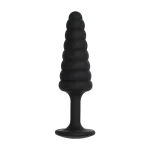 Butt Plugs
Butt Plugs Prostate Massagers
Prostate Massagers
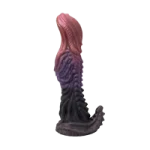 Alien Dildos
Alien Dildos Realistic Dildos
Realistic Dildos
 Kegel Exercisers & Balls
Kegel Exercisers & Balls Classic Vibrating Eggs
Classic Vibrating Eggs Remote Vibrating Eggs
Remote Vibrating Eggs Vibrating Bullets
Vibrating Bullets
 Bullet Vibrators
Bullet Vibrators Classic Vibrators
Classic Vibrators Clitoral Vibrators
Clitoral Vibrators G-Spot Vibrators
G-Spot Vibrators Massage Wand Vibrators
Massage Wand Vibrators Rabbit Vibrators
Rabbit Vibrators Remote Vibrators
Remote Vibrators
 Pocket Stroker & Pussy Masturbators
Pocket Stroker & Pussy Masturbators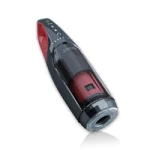 Vibrating Masturbators
Vibrating Masturbators
 Cock Rings
Cock Rings Penis Pumps
Penis Pumps
 Wearable Vibrators
Wearable Vibrators Blindfolds, Masks & Gags
Blindfolds, Masks & Gags Bondage Kits
Bondage Kits Bondage Wear & Fetish Clothing
Bondage Wear & Fetish Clothing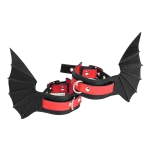 Restraints & Handcuffs
Restraints & Handcuffs Sex Swings
Sex Swings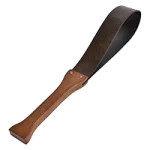 Ticklers, Paddles & Whips
Ticklers, Paddles & Whips






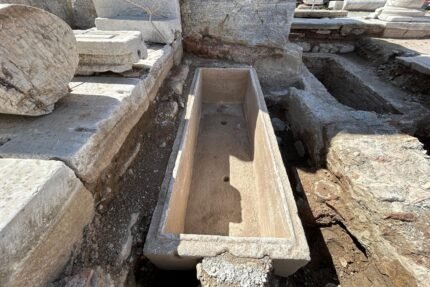
 Mimaroglu provides information on the church associated with the mausoleum. It was originally a small funerary structure, later converted into a wooden-roofed basilica during the reign of Justinian I, and eventually into a domed church.
Mimaroglu provides information on the church associated with the mausoleum. It was originally a small funerary structure, later converted into a wooden-roofed basilica during the reign of Justinian I, and eventually into a domed church.
